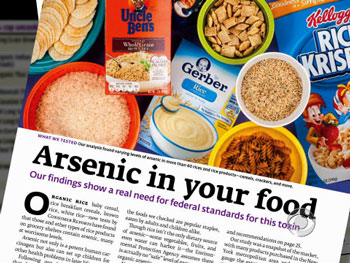Worrisome levels of arsenic found in more than 60 different rice and rice products including infant cereals
A report by consumerreports.org sugests that brown rice, white rice, rice breakfast cereals and organic rice baby cereals, all contain concerning levels of arsenic that is a known carcinogen, harming the human body. Besides rice products, arsenic can be found in fruits, vegetables, conventionally raised chickens and water.
The tests performed by Consumers Reports showed that significant levels of inorganic arsenic along with organic arsenic (which is less toxic but it’s still a concern) was found in 60 different rice and rice products. According to EPA, there is no ‘safe’ limit of exposure to inorganic arsenic, but FDA considers the current level of arsenic in foods within ‘safety’ limits.

More disturbingly, the Organic Consumers report shows that infant rice cereals which are the baby’s first solid foods have five times more inorganic arsenic than other alternatives such as oatmeal.
Key points regarding Organic Consumers report and the extent of arsenic present in our food:
1. White rice grown in Arkansas, Louisiana, Missouri, and Texas, which account for 76 percent of domestic rice, generally had higher levels of total arsenic and inorganic arsenic in our tests than rice samples from elsewhere.
2. Within any single brand of rice we tested, the average total and inorganic arsenic levels were always higher for brown rice than for white.
3. In brands for which we tested both white and brown rice, the average total and inorganic arsenic levels were higher in the brown rice than in the white rice of the same brand in all cases. Among all tested rice, the highest levels of inorganic arsenic per serving were found in some samples of Martin Long Grain Brown rice, followed by Della Basmati Brown, Carolina Whole Grain Brown, Jazzmen Louisiana Aromatic Brown, and Whole Foods’ 365 Everyday Value Long Grain Brown.
4. Though brown rice has nutritional advantages over white rice, it is not surprising that it might have higher levels of arsenic, which concentrates in the outer layers of a grain. The process of polishing rice to produce white rice removes those surface layers, slightly reducing the total arsenic and inorganic arsenic in the grain. In brown rice, only the hull is removed. Arsenic concentrations found in the bran that is removed during the milling process to produce white rice can be 10 to 20 times higher than levels found in bulk rice grain.
5. We also tested for lead and cadmium, other metals that can taint food. The levels we found were generally low overall. Based on our recommended limits for rice products, even the few samples with elevated lead and cadmium should not contribute significantly to dietary exposure.
4. People who ate rice regularly had arsenic levels that were 44 percent greater than those who had not, according to our analysis of federal health data. And certain ethnic groups were more highly affected, including Mexicans, other Hispanics, and a broad category that includes Asians.
5. Reducing arsenic in food is feasible. We examined the efforts of two food companies, including Nature's One, trying to tackle the problem and learned about methods being used to try to reduce arsenic in products.
6. Based on these findings, our experts are asking the Food and Drug Administration to set limits for arsenic in rice products and fruit juices as a starting point.
However, FDA suggests that there are no short-term health risks associated with presence of arsenic in rice and rice products, so eat up!

What has happened to our food industry that eating brown rice (a good source of fiber) can put you in higher risk of exposure to a carcinogen such as arsenic.
FDA who should be in charge of protecting consumers from harmful additives, toxins and heavy metals such as arsenic is instead protecting the interests of multibillion dollar food corporations who don’t’ give a damn about you or your children’s health.
To your surprise, conventionally raised chickens are treated with an arsenical drug known as nitarsone that is used to enhance the growth of chickens and treat intestinal parasites in birds. The level of arsenic in conventionally raised chickens is even higher than rice. However, FDA that considers high levels of arsenic in conventionally raised chickens as 'safe' is going after organic farmers who are raising free-range chickens. Click here to find more how conventionally grown chickens are contaminated with arsenic.
Our air, water, soil and foods are polluted with known carcinogens and then we wonder why majority of people suffer from all kinds of chronic diseases. FDA might be right that there are no immediate health risks from being exposed to fairly high levels of arsenic in rice, rice products or chickens; however, no one can deny that long-term exposure to arsenic cannot be good for health.
Obviously, FDA believes that there is a limit on how much poison can be tested on human beings since arsenic, a known carcinogen, is not just ‘allowed’ but called ‘safe’ in many foods including cereals, chicken and rice. It’s almost laughable that FDA believes that we should not take any further action until it’s proven that eating rice contaminated with arsenic can pose a serious health risk and start killing people.
Allan Smith, a professor of epidemiology at the University of California, Berkeley says “we already know that high concentrations of arsenic in drinking water result in the highest known toxic substance disease risks from any environmental exposure. So we should not be arguing to wait for years until we have results of epidemiologic studies at lower arsenic intake, such as from rice consumption, to take action.”
Studies show that many people in US are already exposed to high levels of arsenic through rice consumption:

The findings of a 2011 study published by the Dartmouth Children’s Environmental Health and Disease Prevention Research Center shows that consuming more than a half of cup of cooked rice a day can result in significant exposure to high levels of arsenic. The authors also suggest that “many people in the U.S. may be exposed to potentially harmful levels of arsenic through rice consumption.”
Although the USA Rice Federation tells consumers not to worry about arsenic in rice and in their website they describe arsenic as “a naturally occurring element in soil and water that plants can take it up”, many scientific studies have linked arsenic to variety of cancers including bladder, lung, liver, kidney, prostate and skin.
So how does arsenic get into our soil or water?
Although arsenic can enter our soil and water via arsenic-containing minerals in nature, human beings are much more to blame for arsenic contamination than Mother Nature. There might be contamination in nature, but nature will always find a way to filter and balance toxins without significant harms to other living organisms. However, there is a whole new ball game, when human beings are involved and deliberately release million tons of agricultural and industrial pollution into the air, water and soil.
For example, according to Consumer Reports, the US is the world’s leading user of arsenic and since 1910, about 1.6 million tons of arsenic have been used for industrial and agricultural purposes (For example, arsenic-laden manure is used as fertilizer.). Where do you think 1.6 million tons of arsenic go?
They don’t simply dissipate into the air and vanish away. They eventually find their way into our air, water and soil and we eat them in our daily fruits, vegetables and foods. Most amazingly, arsenic is also allowed in animals’ feed to prevent diseases such as intestinal parasites and enhance growth. According to a report by the European Food Safety Authority, mainly because of rice, cereal products could account for more than half of dietary exposure to inorganic arsenic. Among many plants that absorb arsenic from soil, grains such as rice absorbs arsenic much more quickly and effectively.
Infant Cereals are a big concern:
The report by Organic Consumers shows concerning level of arsenic in many infant cereals used for ages between 4 and 12 . According to Organic Consumers, Gerber SmartNourish Organic Brown Rice cereal had one sample with the highest level of total arsenic in the category at 329 ppb, and another sample had the lowest total level in this category at 97.7 ppb. It had 0.8 to 1.3 micrograms of inorganic arsenic per serving. Earth’s Best Organic Whole Grain Rice cereal had total arsenic levels ranging from 149 ppb to 274 ppb, but higher levels of inorganic arsenic per serving, from 1.7 to 2.7 micrograms.
It’s a smart decision to limit your exposure and the exposure of your children to rice and rice products. “The need for a standard for arsenic in food is long overdue,” says Trudy Bialic, director of public affairs for PCC Natural Markets in Seattle. “Certainly there are excellent and committed people in FDA’s ranks, but it’s shameful the agency has not addressed this problem more systematically, leaving us to figure it out on our own to protect ourselves” She said.
Here is the full report by Organic Consumers about the level of arsenic in our food:

Sources:
http://www.consumerreports.org/cro/magazine/2012/11/arsenic-in-your-food/index.htm


